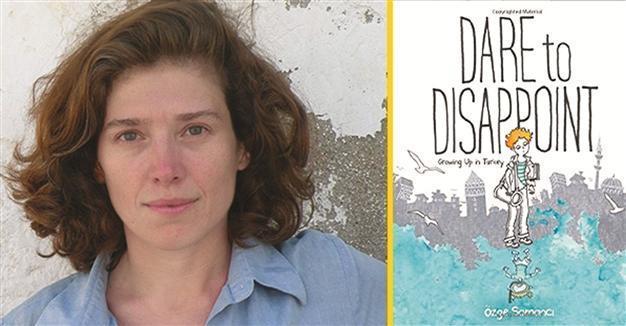Artist's comic book revives 1980s Turkey
ISTANBUL – Anadolu Agency

After the book attracted attention in the Turkish media, four publishing houses expressed interest in translating the work into Turkish.
A homemade birthday present is an unlikely starting point for a groundbreaking graphic novel about a Turkish woman’s childhood. But a notebook full of stories given to a friend by Turkish artist Özge Samancı 15 years ago is the inspiration behind what has become a gripping and innovative account of life in 1980s and 1990s Turkey.
“Dare to Disappoint: Growing Up in Turkey,” a 200-page illustrated memoir in English, is the first book by Samancı – an İzmir native born in 1975 who has been living in the United States since 2003.
Samancı said her target audience was people “who do not know about the issues in Turkey.”

“The readers who are not familiar with the culture and history of Turkey will be introduced to the trickiness of life in Turkey, the difficulty of survival, the absurdity of politics, the challenge of being a woman in a developing country, the meaning of friendship, love of the sea, the impact of politics in the 1980s and 1990s on the middle class,” she said.
“They will also learn about our dysfunctional education system, which traps people into careers for which they have no passion,” she added.
The book, which was released on Nov. 17, introduces readers to a time when Turkey experienced one of its most violent military coups, claiming hundreds of lives. It also covers a period of market liberalization and profound social, cultural and economic change.
American TV dramas such as “Dallas” and “The Young and The Restless” had an important impact on Turkish society during the same period. “While people were fascinated with the lifestyle in ‘Dallas,’ they elected a new prime minister, Turgut Özal, whose dream was to transform Turkey into a little U.S.,” an accompanying caption reads.
Spending millions for a gum
On another page, Samancı draws a caricature of the old Turkish Lira, which Turks used to spend by the million to purchase even a packet of chewing gum.
Her book also features caricatures of Özal as well as the then-president, Gen. Kenan Evren. Elsewhere, Özge and her sister Pelin envy their friend Engin, whose father becomes rich by exporting textiles during the Özal era.
While Engin was wearing fancy clothes, carrying a Walkman and reading foreign magazines, which were difficult to find at the time in Turkey, Özge and her sister wore items sewn by their mother and second-hand sports shoes.
Samancı herself studied mathematics but became a teaching assistant in the Visual Communication Design Department of Istanbul Bilgi University.
“It is irrelevant to mathematics but I believe they hired me since I was making comics for Leman,” she said, referring to a Turkish satirical magazine.
After earning a Master’s degree in film at Bilgi University, she became a lecturer in the college’s design department.
Although the idea of writing a book was in her mind for the last 15 years, she just did not know where to start, but she recalls a birthday present that she made for one of her friends being a turning point. “I filled an entire notebook with anecdotes from my childhood,” she said. “That notebook became popular among our friends. Ever since then, I have wanted to make an autobiographical graphic novel.”
 Online comic journal
Online comic journal
It was 2006 when Samancı launched her own online comic journal called “Ordinary Things,” just to entertain her friends. According to Samancı, the website is visited by around 9,000 people every day. While Samancı was a postdoctoral fellow at the University of California, Berkeley, in 2010, she created two full chapters of “Dare to Disappoint” and found an agent who sold the book to a publishing company in less than a month.
The actual production of the work took three years, said Samancı, who is currently working as an assistant professor at Northwestern University in Illinois. “The negotiations with the editor took time,” she said. “She had her own concerns about making the story understandable for readers who are not familiar with the history of Turkey.”
Since the book attracted attention in the Turkish media, Samancı said four publishing houses are now interested in translating her work into Turkish.
The book has already been number one in online bookseller Amazon’s young-adult category.
U.S. magazine Publishers Weekly has praised the book, writing: “Samancı’s caricatures of herself and the people around her, often drawn wide-eyed with surprise, make the sporadic episodes of political strife and urban violence oddly incongruous. But they’re a crucial component of the story, one that resounds with honesty and humor.”
Although today’s Turkey is much different from what is described in Samancı’s book, her memoir is a good start for people who want to learn about Turkey’s transition from a closed country to an open market.

 “The readers who are not familiar with the culture and history of Turkey will be introduced to the trickiness of life in Turkey, the difficulty of survival, the absurdity of politics, the challenge of being a woman in a developing country, the meaning of friendship, love of the sea, the impact of politics in the 1980s and 1990s on the middle class,” she said.
“The readers who are not familiar with the culture and history of Turkey will be introduced to the trickiness of life in Turkey, the difficulty of survival, the absurdity of politics, the challenge of being a woman in a developing country, the meaning of friendship, love of the sea, the impact of politics in the 1980s and 1990s on the middle class,” she said. Online comic journal
Online comic journal